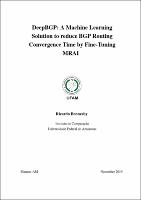| ???jsp.display-item.social.title??? |


|
Please use this identifier to cite or link to this item:
https://tede.ufam.edu.br/handle/tede/7697| ???metadata.dc.type???: | Tese |
| Title: | DeepBGP: A Machine Learning Solution to reduce BGP Routing Convergence Time by Fine-Tuning MRAI |
| Other Titles: | A Machine-Learning Solution to reduce BGP Routing Convergence Time in a Hybrid SDN-Interdomain environment by Fine-Tuning MRAI |
| ???metadata.dc.creator???: | Silva, Ricardo Bennesby da  |
| ???metadata.dc.contributor.advisor1???: | Mota, Edjard Souza |
| ???metadata.dc.contributor.referee1???: | Feitosa, Eduardo Luzeiro |
| ???metadata.dc.contributor.referee2???: | Santos, Eulanda Miranda dos |
| ???metadata.dc.contributor.referee3???: | Souza, Jose Neuman de |
| ???metadata.dc.contributor.referee4???: | Cunha, Italo Fernando Scotá |
| ???metadata.dc.description.resumo???: | The organization of the Internet is composed of administrative domains, known as Autonomous Systems (ASes), that exchange reachability information by means of the Border Gateway Protocol (BGP). Since a high convergence delay leads to packet losses and service unavailability, such a protocol has to converge as fast as possible. As this can happen due to BGP's own mechanism of UPDATE messages, that produces a humongous amount of messages, BGP reduces the number of UPDATEs exchanged between two BGP routers by holding consecutive announcements from a router to a neighbor for a given amount of time. The BGP timer responsible for this task is called Minimum Route Advertisement Interval (MRAI), which has an important impact in routing convergence. The Software-Defined Networking (SDN) paradigm can be used to leverage interdomain routing services performance via the logically centralized controlling benefits of intradomain settings. SDN principles has been successfully deployed in data centers, LANs, and in several other studies, where each each AS is modeled with a logically centralized routing control, offering new opportunities and bringing BGP routing convergence improvements. In this work, an extensive survey is presented on the state-of-the-art about research efforts to achieve better BGP routing convergence time. Furthermore, I pinpoint the open issues in this research field and propose DeepBGP, to the best of my knowledge, the first hybrid framework endowed with a learning mechanism, that integrates the SDN paradigm within interdomain routing domains, to improve the interdomain routing convergence time. This is achieved by employing the LSTM learning technique that allows the tuning of MRAI value aiming to reduce the convergence time according to learned patterns from collected BGP UPDATE features. The PEERING platform was used to provide a real scenario that allows the sending of announcements to the Internet. With the benefits of having such an actual testbed I carried out experiments with protocol characteristics that can impact the routing convergence. The experimental results show that the adaptive MRAI in the DeepBGP framework is able to reduce the BGP routing convergence time when compared to the use of static MRAIs. |
| Abstract: | The organization of the Internet is composed of administrative domains, known as Autonomous Systems (ASes), that exchange reachability information by means of the Border Gateway Protocol (BGP). Since a high convergence delay leads to packet losses and service unavailability, such a protocol has to converge as fast as possible. As this can happen due to BGP's own mechanism of UPDATE messages, that produces a humongous amount of messages, BGP reduces the number of UPDATEs exchanged between two BGP routers by holding consecutive announcements from a router to a neighbor for a given amount of time. The BGP timer responsible for this task is called Minimum Route Advertisement Interval (MRAI), which has an important impact in routing convergence. The Software-Defined Networking (SDN) paradigm can be used to leverage interdomain routing services performance via the logically centralized controlling benefits of intradomain settings. SDN principles has been successfully deployed in data centers, LANs, and in several other studies, where each each AS is modeled with a logically centralized routing control, offering new opportunities and bringing BGP routing convergence improvements. In this work, an extensive survey is presented on the state-of-the-art about research efforts to achieve better BGP routing convergence time. Furthermore, I pinpoint the open issues in this research field and propose DeepBGP, to the best of my knowledge, the first hybrid framework endowed with a learning mechanism, that integrates the SDN paradigm within interdomain routing domains, to improve the interdomain routing convergence time. This is achieved by employing the LSTM learning technique that allows the tuning of MRAI value aiming to reduce the convergence time according to learned patterns from collected BGP UPDATE features. The PEERING platform was used to provide a real scenario that allows the sending of announcements to the Internet. With the benefits of having such an actual testbed I carried out experiments with protocol characteristics that can impact the routing convergence. The experimental results show that the adaptive MRAI in the DeepBGP framework is able to reduce the BGP routing convergence time when compared to the use of static MRAIs. |
| Keywords: | Gerenciamento de redes Roteamento entre domínios Tempo de convergência Border Gateway Protocol Long Short-Term Memory Long Short-Term Memory |
| ???metadata.dc.subject.cnpq???: | CIÊNCIAS EXATAS E DA TERRA: CIÊNCIA DA COMPUTAÇÃO: SISTEMAS DE COMPUTAÇÃO |
| ???metadata.dc.subject.user???: | bgp convergence time lstm network management interdomain routing |
| Language: | eng |
| ???metadata.dc.publisher.country???: | Brasil |
| Publisher: | Universidade Federal do Amazonas |
| ???metadata.dc.publisher.initials???: | UFAM |
| ???metadata.dc.publisher.department???: | Instituto de Computação |
| ???metadata.dc.publisher.program???: | Programa de Pós-graduação em Informática |
| Citation: | SILVA, Ricardo Bennesby da. DeepBGP: a machine learning solution to reduce BGP routing convergence time by Fine-Tuning MRAI. 2019. 141 f. Tese (Doutorado em Informática) - Universidade Federal do Amazonas, Manaus, 2019. |
| ???metadata.dc.rights???: | Acesso Aberto |
| URI: | https://tede.ufam.edu.br/handle/tede/7697 |
| Issue Date: | 18-Nov-2019 |
| Appears in Collections: | Doutorado em Informática |
Files in This Item:
| File | Description | Size | Format | |
|---|---|---|---|---|
| Tese_RicardoBennesby_PPGI.pdf | Tese_RicardoBennesby_PPGI | 5.24 MB | Adobe PDF |  Download/Open Preview |
Items in DSpace are protected by copyright, with all rights reserved, unless otherwise indicated.




